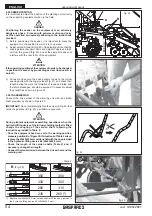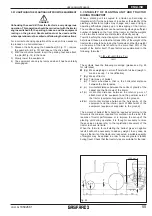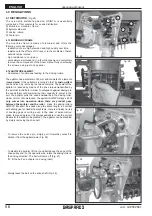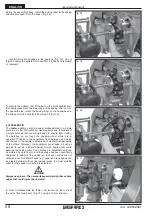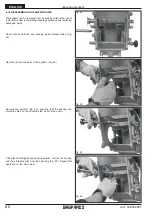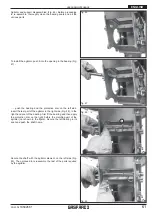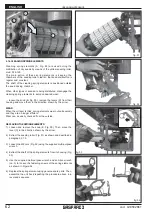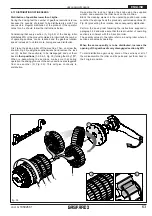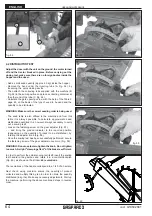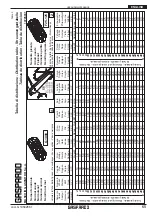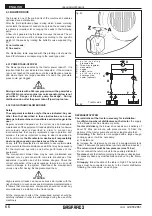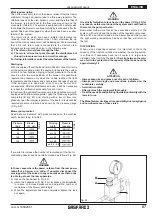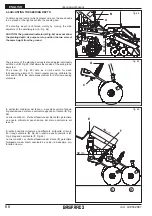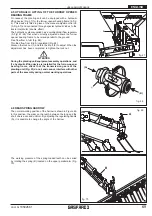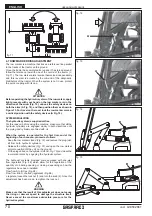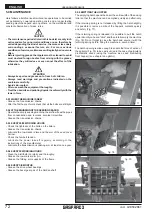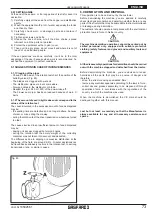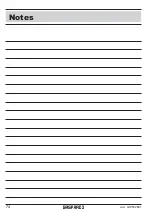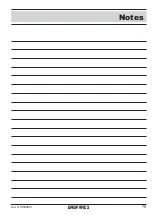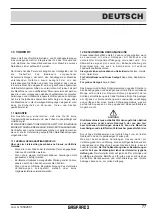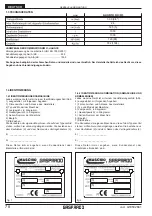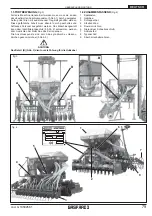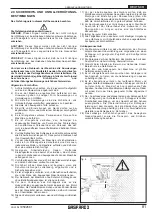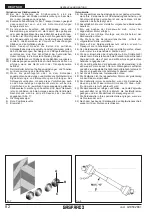
USE AND MAINTENANCE
67
ENGLISH
g
cod. G19502661
Working description
The oil flow necessary to drive the blower, is taken from the tractor
distributor, through a pressure tube to a three-way regulator. The
rotational speed of the oleo-dynamic motor, and therefore that of
the blower, is proportional to the flow pressure shown on the
manometer (Table 4). The system is equipped with a safety valve
that allows the blower to continue turning by inertia even after the
system has been disengaged or when there has been a sudden
failure of the system.
The return circuit, which can have a radiator incorporated (on
request), must be low pressure (max 10 bar) otherwise the oil-
seal of the oleo-dynamic motor will be damaged. We recommend
that a 3/4 inch return pipe is connected to the tractor’s oleo-
dynamic system scavenge union in the following way:
a) The return oil must pass through the filter;
b) The return oil must not pass through the distributors but
through a low-pressure return circuit (scavenge).
For further information contact the manufacturer of the tractor.
Starting up
With the engine off and the tractor immobilized, connect correctly
all the quick-couplings. Start the engine and operate the system
at idle for a few minutes bringing constant pressure to the entire
circuit in order to avoid instability of the blower. It is possible to
regulate the pressure only when the oil has reached the right
temperature and the blower does not present changes of speed.
If the equipment is used with more than one tractor and,
consequently, different distributors and oils, it will be necessary
to repeat the calibration procedure for each tractor.
In tractors with a variable flow rate pump (closed hydraulic circuit),
equipped with oil flow rate regulator, open the three-way regulator
completely (B Fig. 63) and, starting with a low oil flow rate,
gradually open the internal regulator of the tractor circuit until the
required pressure is reached as shown by the pressure gauge
(C Fig. 62).
Blower pump control:
Seed drills are delivered with pressure based on the machine
width, as according to Table 5.
If you wish to increase the number of revolutions of the fan for
distributing heavier seeds, carefully proceed as follows (Fig. 63):
WARNING
In those cases where the power is taken from the rear power
take-off of a harrow or a miller, if possible disconnect the
moving parts of the knives. In any case, make sure that no one
is able to get near the rear apparatus.
a) loosen the handwheel (A Fig. 63);
b) rotate the handwheel (B Fig. 63) clockwise or anticlockwise
to reduce or increase pressure and adjust the number of
revolutions of the blower accordingly.
c) When the adjustment has been completed, tighten the lock
nut again.
Pressure
(bar)
Blower
(N giri)
Working
width
Pressure
required
80
mt. 2,5
90
mt. 3,0
120
mt. 4,0
140
mt. 5,0
mt. 6,0 - 9,0
T
able 4
T
able 5
fig. 63
A
B
C
WARNING
It is strictly forbidden to touch act on the dowel (C Fig. 63) for
any reason, as this would unset the system and could lead to
the motor, the pump or the fan.
Remember furthermore that at the successive start-up of the
system, with cold oil and the position of the regulator untouched,
there will be an initial increase in the blower speed which, once
the right working temperature has been reached, will return to
that set.
OIL COOLING
When using a dependent system it is important to check the
capacity of the tractor’s oil tank and whether the cooling system
is sufficient. If necessary have an oil cooler or a larger tank
installed on the tractor by the dealer:
the ratio between the volu-
me of oil in the system and the capacity of the tank should be
approximately 1:2
.
ATTENTION
- Always keep oils and grease out of reach of children.
- Always read warnings and precautions indicated on the
containers carefully.
- Avoid skin-contact.
- After use wash the equipment thoroughly.
- Treat the used oils and polluting liquids in conformity with the
laws in force.
The Manufacturer declines all responsibility due to negligence
and non-observance of these rules.
Summary of Contents for ALIANTE DD
Page 4: ...cod G19502661 g 4...
Page 38: ...cod G19502661 g 38 Notes...
Page 39: ...39 cod G19502661 g Notes...
Page 40: ...cod G19502661 g 40...
Page 74: ...cod G19502661 g 74 Notes...
Page 75: ...75 cod G19502661 g Notes...
Page 76: ...cod G19502661 g 76...
Page 110: ...cod G19502661 g 110 Notes...
Page 111: ...111 cod G19502661 g Notes...
Page 112: ...cod G19502661 g 112...
Page 146: ...cod G19502661 g 146 Notes...
Page 147: ...147 cod G19502661 g Notes...
Page 148: ...cod G19502661 g 148...
Page 182: ...Notes...


